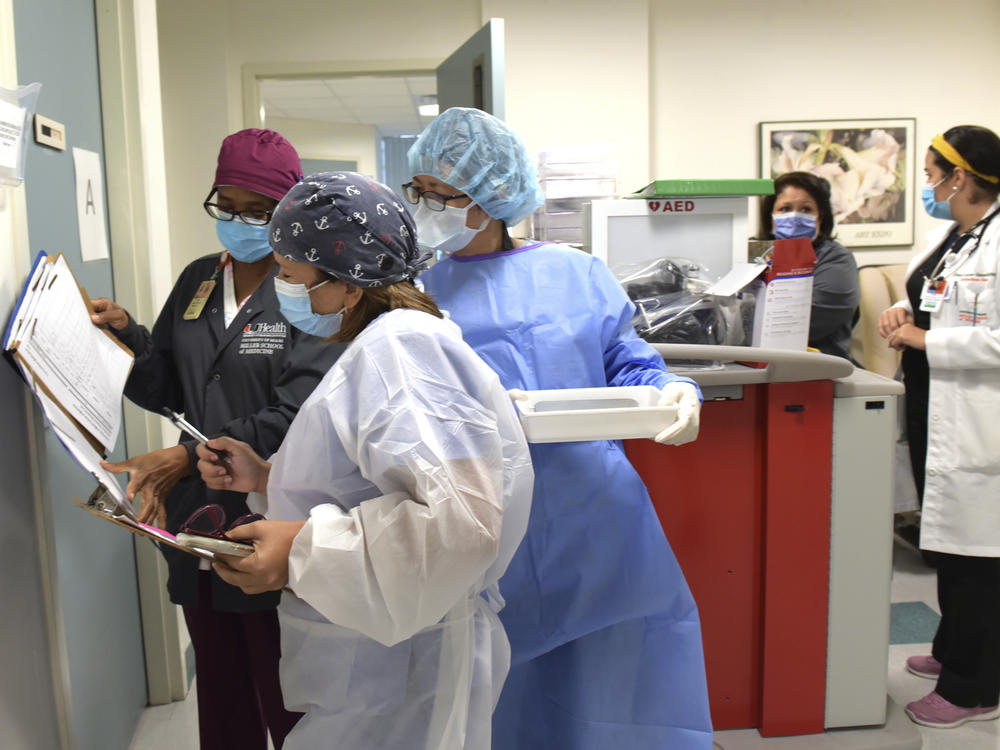Section Branding
Header Content
Why Tens Of Thousands Of People Are Key To Testing A COVID-19 Vaccine
Primary Content
Updated at 7:00 a.m. ET
More than 100,000 people are taking part in studies to see if one or more COVID-19 vaccine candidates actually work.
Janssen Pharmaceutical Cos. of Johnson & Johnson today starts wide-scale testing for its vaccine. It will involve as many as 60,000 volunteers worldwide. AstraZeneca, Pfizer and Moderna already have vaccine candidates in large studies in the United States. Novavax should start its study later this fall.
The reason the trials are so large has to do with the complications of getting an accurate analysis of whether the vaccine works — and how the scientists and public health officials define "works."
Why so many people?
A large trial maximizes the likelihood the study will capture people who span the gamut of behavior, jobs and lifestyles. To prove a vaccine works, people taking part in a study must at some point be exposed to the virus. But herein lies a conundrum — it's unethical to ask people to expose themselves intentionally. Indeed, volunteers in vaccine studies are encouraged to continue to take steps to avoid infection: wash hands frequently, avoid crowds, wear a mask, maintain 6 feet of social distance.
"Some people will not be able to adhere to that, and some people will have exposure just by the nature of the work they do," says Ruth Karron, director of the Johns Hopkins Vaccine Initiative. "For example, if they are health care workers or other kinds of front-line workers."
So some people will inevitably be exposed to the virus.
Large numbers are also needed because some of these volunteers will get injected with an inert placebo instead of the vaccine candidate. Each study looks to see if there's a difference in the rate of infection in the placebo group compared with the vaccinated group.
Finally, having large numbers of people vaccinated might reveal unexpected, rare side effects that might not have shown up in the initial, small-scale studies.
If there's a difference between the two groups, how do researchers know the vaccine is responsible for preventing infection?
Randomization is the key to assuring that the vaccine is playing a role in keeping people from getting the coronavirus. Some of the volunteers will, just by their nature and habits, be extremely cautious and take aggressive steps to avoid exposure to the virus. Others will not. Since volunteers are randomly assigned either to the placebo or the vaccine group, it's reasonable to assume that the two groups will have roughly equal numbers of daredevils and cautious people and everything in between. If there is a significant difference in the rate of COVID-19 illness experienced by the two experimental groups, the vaccine is the likely explanation.
Also, the experimental trial is what's called "double blind." That means neither the person jabbing the needle in someone's arm, nor the person injected, knows what's in the syringe. Volunteers might be tempted to throw caution to the wind and deliberately expose themselves to the virus if they thought they were receiving a vaccine candidate. But since they don't know what they're getting — and the persons administering the vaccine can't give them a hint since they don't know either — throwing caution to the wind seems risky if all the volunteer got was some saline injected into an arm. Besides, the vaccine is experimental, meaning it might not work.
How do researchers know if anybody is actually being exposed to the virus?
In reality, researchers don't know if the volunteers are getting exposed to the virus, but they try to conduct trials in areas where the virus is known to be circulating in the community.
Picking a good location is tricky.
"It's not that you actually want there to be a lot of virus there right at the moment you get the first injection," Karron says. That's because it takes several weeks after that first injection for a person's immune system to respond in a way that would protect them from disease. So researchers must try to predict where the virus will still be circulating weeks or months into the future.
How did researchers decide on their target of 30,000 volunteers?
Having 30,000 volunteers participate is also partly because there's a need for speed. The key to determining if the vaccine works is to get enough cases of COVID-19 to be able to make statistically reliable comparisons between the vaccinated group and the placebo group. Researchers estimate 150 cases should be enough to prove that a vaccine is at least 50% effective. The large number of volunteers in each study is an effort to make sure those 150 cases occur as rapidly as possible.
Is there a way to show efficacy with fewer people?
There is a way to show efficacy with fewer people, but the approach is ethically fraught. Some have argued for challenge trials in which volunteers are vaccinated and then deliberately exposed to the virus by inserting the virus directly into their noses. But without an effective COVID-19 treatment, researchers in that sort of study could be killing people if the vaccine didn't work. It's also likely that volunteers in a challenge trial would be healthy, young individuals. Their response to the vaccine might be different from the way older people or people with medical conditions might respond. What's more, a small-scale challenge trial would not reveal any rare side effects a vaccine might cause.
When will the vaccine studies underway have results?
It's impossible to say for certain when some of the studies will have results, but some scientists and public health officials estimate it could be as early as the end of October.
You can contact NPR science correspondent Joe Palca at jpalca@npr.org.
Copyright 2020 NPR. To see more, visit https://www.npr.org.

